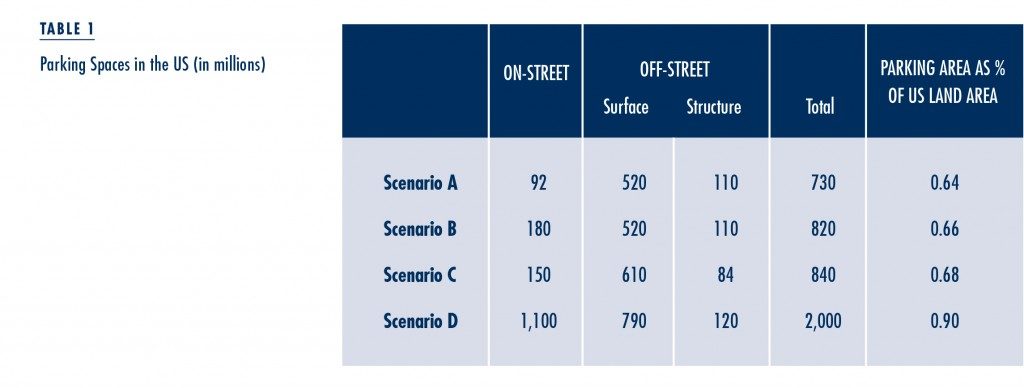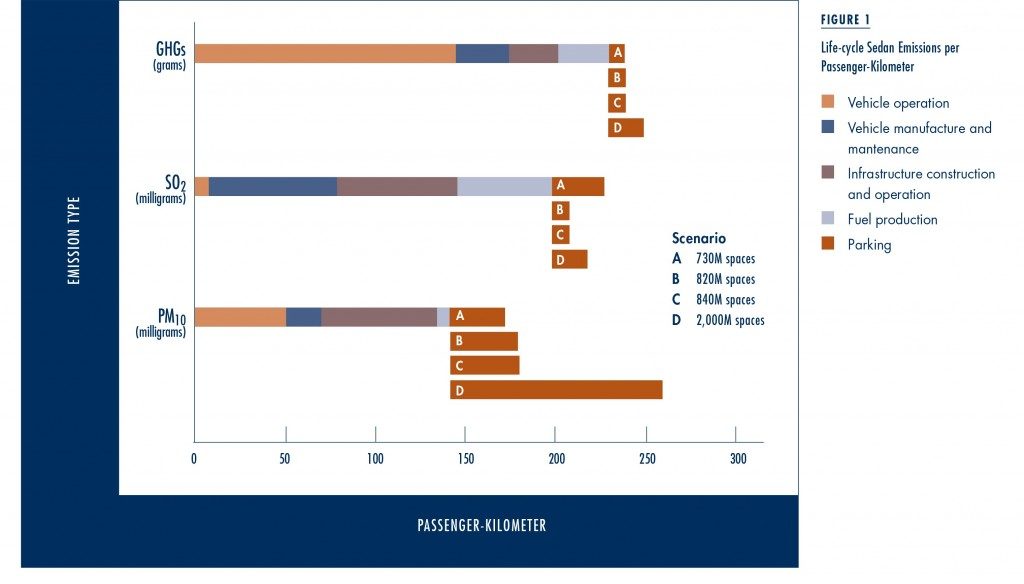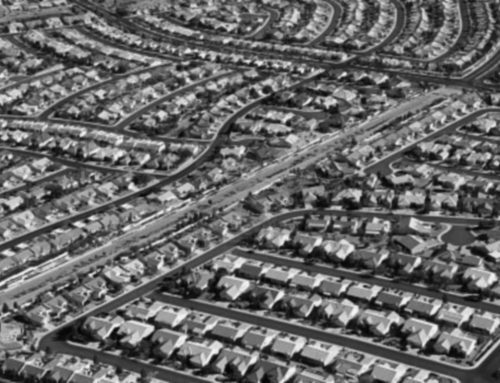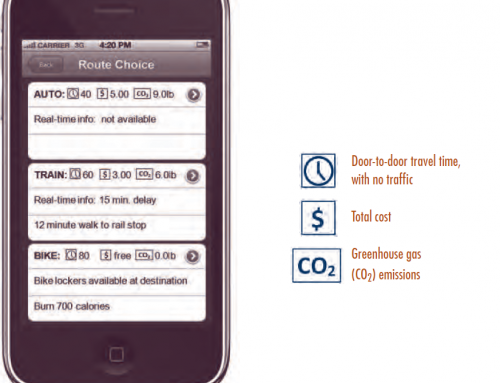We know surprisingly little about how parking infrastructure affects energy demand, the environment, and the social cost of vehicle travel. Passenger and freight movements are often the focus of energy and environmental assessments, but vehicles spend most of their lives parked. Because abundant free parking encourages solo driving and thus discourages walking, biking, and the use of public transit, it greatly contributes to urban congestion. The environmental impacts of parking and the driving it promotes are often borne by local populations and not the trip-takers themselves.
The transportation life-cycle assessment (LCA) framework allows us to understand the full costs of travel, including energy use and environmental effects. Past LCAs, however, have focused on evaluating the resources directly used for travel and have not considered the extensive parking infrastructure, including the costs of its construction, operation, maintenance, and raw material extraction and processing. This narrow focus is understandable given the diversity of parking spaces and the lack of available data on parking infrastructure. For example, consider the great differences in energy use and emissions associated with curb parking spaces, multi-story garages, and private home garages. Furthermore, it is difficult to assign the energy use and environmental effects of parking to individual actors. Should we assign the cost of parking to an automobile driver, or to the builder of the strip mall where the driver shops, or to the shop where the driver parks?
For many vehicle trips the environmental cost of the parking infrastructure sometimes equals or exceeds the environmental cost of the vehicles themselves.
To determine the full social cost of parking, we develop a range of estimates of the US parking space inventory and determine the energy use and environmental effects of constructing and maintaining this parking. We find that for many vehicle trips the environmental cost of the parking infrastructure sometimes equals or exceeds the environmental cost of the vehicles themselves. Evaluating life-cycle effects, including health care and environmental damage costs, we determine that emissions from parking infrastructure cost the US between $4 and $20 billion annually, or between $6 and $23 per space per year.
A US Parking Space Inventory
 To estimate the number of parking spaces in the US, we have developed multiple scenarios that include survey data and new estimates for different types of parking spaces. We evaluate on-street, surface, and structured spaces.
To estimate the number of parking spaces in the US, we have developed multiple scenarios that include survey data and new estimates for different types of parking spaces. We evaluate on-street, surface, and structured spaces.
There are roughly 240 million passenger vehicles and 10 million on-road freight vehicles in the US. All passenger vehicles require a home base and commuting vehicles also require a work space. In addition, using data from a nationwide inventory, we reach a figure of 105 million metered spaces. We add to this running total several different estimates of the number of additional spaces of different types, and summarize the estimates and their resulting land use characteristics in four possible scenarios in Table 1.
Scenario A includes the number of parking spaces at commercial sites, derived from national estimates of commercial floor area and the minimum parking requirements for each land use. This is added to the home spaces, work spaces, and the metered space inventory, taking into account the overlap between commercial square foot estimates and work spaces. Scenario A, with 722 million spaces, can be considered a conservative inventory before taking into account the high uncertainty about the number of on-street non-metered spaces.
In Scenario B, we evaluate roadway design guidelines and distances of urban and rural roadways to determine nationwide on-street parking. This estimate takes the mileage of non-bridge and non-tunnel urban arterial, collector, and local roadway shoulders and assumes that one-half of their potential area is designated as on-street parking with either one or both shoulders used. Adding this to Scenario A’s estimate produces 810 million spaces. While Scenario B includes on-street parking, the estimate conservatively assumes that a small fraction of curbside urban roadway area is actually designated as parking.
Scenario C is based on observed ratios of four spaces per vehicle for cities and 2.2 spaces per vehicle for rural areas. Scenario C weights these ratios by urban and rural vehicle travel to produce a nationwide average of 3.4 spaces per vehicle, or 844 million spaces.
Finally, Scenario D is based on an unverified estimate of 8 spaces per vehicle that is often mentioned in planning literature; it produces an estimate of 2 billion spaces, which is the high end of our range. We include this ratio as an upper-bound assessment that could capture spaces missed in previous scenarios.
Embedded Energy and Emissions in Parking Infrastructure
Valuing and allocating the total cost of parking infrastructure is not simple because not all externalities can be priced, costs are borne by many people, and parking spaces are spread throughout the built environment. However, LCA is a framework to estimate the magnitude of these effects. LCA’s basic tenet is that an activity like parking cannot function without support from other services. Energy use, environmental degradation, and greenhouse gas emissions (GHG) result from parking construction and maintenance activities. Parking’s physical infrastructure requires processed materials, energy, labor, and other inputs, which in turn depend upon their own supply chains. For example, asphalt requires aggregate, which is mined and then must be transported. Each of these activities consumes energy and produces emissions.
Parking’s physical infrastructure requires processed materials, energy, labor, and other inputs, which in turn depend upon their own supply chains.
We evaluate the life-cycle effects of each parking space type and quantify the materials, energy use, GHG emissions, and conventional air pollutant emissions associated with it. After performing this analysis, we then normalize the results to a passenger-kilometer-traveled basis taking into account the varying lifetimes of parking spaces and structures. Our methodology measures only air emissions. Other major impacts from parking infrastructure include heat island effects and alterations to water flows (such as more frequent and higher peak flows, lower water tables, and increased chemical contamination). Thus our LCA costs are lower bound estimates.
Not all energy use and emissions generated by parking can be allocated to the automobile. The availability of parking encourages people to drive, but at the same time high automobile use encourages businesses, developers, and government agencies to provide parking. Accurately allocating all the environmental effects of parking between drivers and other actors is not possible because causality is unclear. However, it is important toillustrate the potential total costs of personal vehicle use. Figure 1 shows total emissions caused directly and indirectly by automobiles if all the LCA emissions from parking are attributed to automobiles.
In some cases larger reductions in environmental impacts may be achieved by focusing on parking infrastructure (and other life-cycle components) instead of the vehicle’s tailpipe, where significant strides towards reducing pollution have already been made. For certain pollutants, parking infrastructure contributes a significant share—and sometimes even the largest share—of life-cycle effects. For example, parking’s contribution to the production of SO2, which causes respiratory damage and acid deposition, largely results from electricity generation in the supply chain. SO2 emissions from parking exceed the SO emissions from driving. The majority of parking-related PM10 emissions, which cause cardiovascular harm, stem from hot-mix asphalt plants as well as the mixing and placing of asphalt. PM10 emissions from parking are about the same as those from driving.
For certain pollutants, parking infrastructure contributes a significant share—and sometimes even the largest share—of life-cycle effects.
Valuing the Impacts of Parking Infrastructure Emissions
Estimating the monetized health and environmental costs of parking infrastructure represents an important step in developing total transportation cost assessments to inform policy decisions. We evaluate these costs using an approach developed by the National Research Council’s Hidden Costs of Energy study. This allows an assessment of the total impact of parking construction and maintenance by assigning damage costs to each pollutant. We can then evaluate the effects of parking in typical high-impact urban and low-impact rural counties. Using these estimates, LCA enables us to attach dollar amounts to the external costs of parking infrastructure.
The parking infrastructure estimated in Scenarios A through C costs the US between $4 and $20 billion per year. Per space, this amounts to between $6 and $23 per year. The low end of this range represents a parking space constructed in a low-density rural area, whereas the high end typifies a space in a high-density urban environment. Everyone bears this cost in the form of adverse health impacts, building damage, and reduced agricultural production, to name a few.
Underpriced parking not only increases automobile dependence but is also environmentally damaging to construct and maintain. We hope that our life-cycle assessment will help planners and public officials understand the full cost of parking.
Further Readings
Mikhail Chester, Arpad Horvath, and Samer Madanat. 2010. “Parking Infrastructure: Energy, Emissions, and Automobile Life-Cycle Environmental Accounting,” Environmental Research Letters, 5 (3).
Mikhail Chester and Arpad Horvath. 2009. “Environmental Assessment of Passenger Transportation Should Include Infrastructure and Supply Chains,” Environmental Research Letters, 4 (2).
National Research Council’s Committee on Health, Environmental, and Other External Costs and Benefits of Energy Production and Consumption. 2010. Hidden Costs of Energy: Unpriced Consequences of Energy Production and Use, National Academies Press.
Nicholas Santero and Arpad Horvath. 2009. “Global Warming Potential of Pavements,” Environmental Research Letters, 4 (3).







